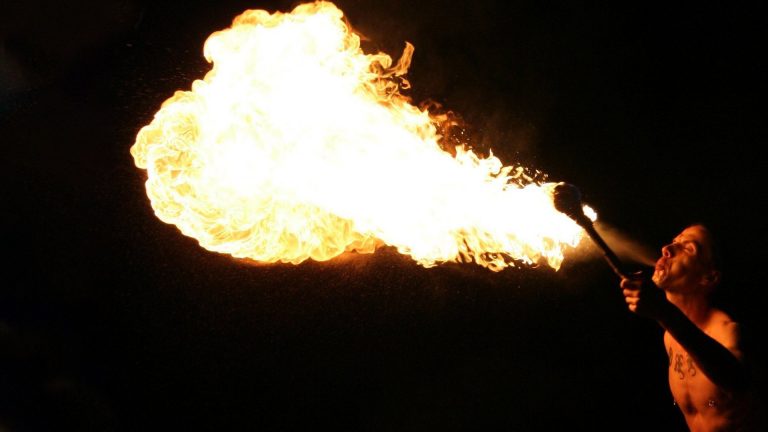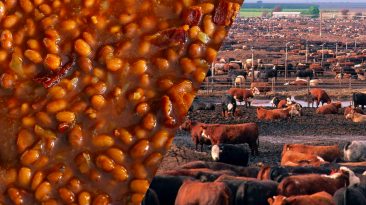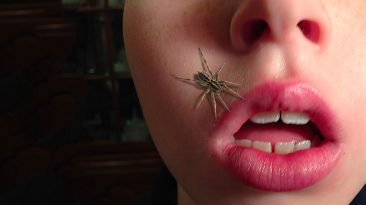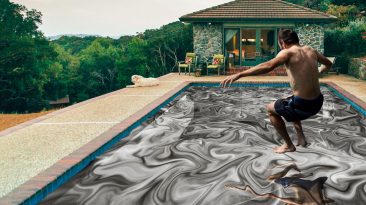Don’t try this at home, kids. You may have seen performers breathe out giant plumes of flames. It’s breathtaking, and extremely dangerous. But the performers aren’t really “breathing” in the fire.
Simply put, fire-breathers spray a mouthful of fuel through a flame. While the fuel mist combusts, the performer makes sure not to inhale. Because, well, it sure wouldn’t tickle if you had a fire in your throat and lungs.
How could we really breathe fire? What dangers would there be with this ability? And how would life change if you could breathe fire?
Dragons. They’re the flying, lizard-like creatures found in many different myths and legends across the world. They’re famous for their gigantic size, their greed for gold, and their fiery, blazing breath.
But, as far as we know, dragons are purely fictional. How could we bring this to reality? How would you have to evolve to breathe like a dragon?
Well, the first thing you’d need is some fuel for your fire. There aren’t any animals that can spit fire, but we can take a look at one with defenses that are just as hot, and just as painful.
The bombardier beetle can spray boiling hot chemicals out of its butt. Gross. It does this by holding a mixture of hydrogen peroxide (H2O2), and chemicals called hydroquinones in its abdomen. When the beetle is threatened, the chemicals empty into a second chamber to start a reaction. The hydrogen peroxide decomposes into oxygen (O2) and boiling water. The hydroquinones oxidize into benzoquinones, an extremely irritating chemical.
Then, the mixture sprays out the tip of its abdomen, incapacitating smaller opponents, or bombarding larger predators with chemical burns. We can take the same idea and apply it to you. Uh, preferably without the shooting chemicals out the butt part.
Believe it or not, you already have flammable, reactive compounds in your body. Hydrogen peroxide is a common metabolic byproduct. It isn’t flammable by itself, but it does enhance the combustion of other substances.
Methane (CH4) is a byproduct of digestion and is extremely flammable. And catalase is an enzyme in our liver that breaks down hydrogen peroxide and speeds up chemical reactions.
Like the bombardier beetle, you could have a new organ to store these byproducts and spit them out when you want to breathe fire. Alright, so now that we’ve got our fire-breathing fuel sorted out, we need a way to set the chemicals ablaze.
A mineral coating on your teeth could make a few sparks, but that might wear them down over time. A theory about how dragons could breathe fire points toward a simple, everyday animal. Birds.
A bird’s gizzard is the second part of its stomach. Birds swallow small stones into their gizzard to help grind up tough foods. If dragons or humans had gizzards, we could swallow and store some flint and steel in our bodies. Then, all you need to do is grind the flint and steel together to spark and ignite the chemicals.
And there you have it, you’re breathing fire. Forget your lighter, you don’t need it. Who needs fire starting kits to go camping anymore? You can be a superhero with your fire-breathing abilities.
But wait, just because you can breathe fire doesn’t mean you’re immune to fire. Your mouth would have to be protected with a fire-resistant coating so you don’t burn your throat.
Fire-resistant plants have saps or resins making them less likely to ignite. These could be used to make fire-breathing more tolerable. Then, there’s your clothes and your house. Everything you wear and all of your belongings would have to be fire-resistant, in case of any accidents.
And, if you like your hair, or your eyebrows, you’ll have to learn how to spew fire properly. Fire-breathers usually spit at a 60 to 80 degree angle, to not catch themselves on fire. You know, as cool and convenient breathing fire might be, it probably wouldn’t be too safe.
Sources
- “Endothermic vs. exothermic reactions”.
- “If Dragons Were Real, Could They Breathe Fire?”. LAURIE L. DOVE, Howstuffworks.
- “Absurd Creature Of The Week: This Beetle Fires Boiling Chemicals Out Of Its Bum”. Simon, Matt. 2014. Wired.
- “Fire Eating And Fire Breathing FAQ”. 2020. juggling.org.
- “Most flames blown in one minute (fire breathing)”. 2015. Guinness World Records.
“Do Fire-Breathing Dragons Torch Their Teeth?”. ROBERT LAMB. Howstuffworks.


















